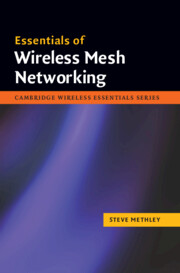Book contents
- Frontmatter
- Contents
- Preface
- Acknowledgements
- 1 Mesh overview and terminology
- 2 Attractive mesh attributes and applications
- 3 Fundamentals of mesh technology
- 4 Mesh capacity, scalability and efficiency – hypothesis testing
- 5 Mesh susceptibility
- 6 Mesh services and quality of service
- 7 Summary of potential mesh pitfalls to avoid
- 8 Appropriate telecommunications applications for mesh
- 9 Successful mesh implementations
- 10 Wireless sensor networks (WSNs) as mesh networks
- Abbreviations
- Selected definitions
- Appendix: Mobility models
- About the author
- Index
- Mesh hints and tips
- Frontmatter
- Contents
- Preface
- Acknowledgements
- 1 Mesh overview and terminology
- 2 Attractive mesh attributes and applications
- 3 Fundamentals of mesh technology
- 4 Mesh capacity, scalability and efficiency – hypothesis testing
- 5 Mesh susceptibility
- 6 Mesh services and quality of service
- 7 Summary of potential mesh pitfalls to avoid
- 8 Appropriate telecommunications applications for mesh
- 9 Successful mesh implementations
- 10 Wireless sensor networks (WSNs) as mesh networks
- Abbreviations
- Selected definitions
- Appendix: Mobility models
- About the author
- Index
- Mesh hints and tips
Summary
Continuing in the spirit developed in the previous chapter, rather than looking at meshes by pursuing a linear layer-by-layer exposition of the protocol stack as in Figure 3.1, we will continue to take a more pragmatically integrated view. This chapter and the next chapter therefore look at two key aspects of mesh systems, or indeed of any communications system; these are susceptibility to interference and quality of service. PHY, MAC, routing, transport and application behaviours along with their interactions are all relevant, although this chapter on susceptibility is more related to the lower layers and Chapter 6 on the quality of service is more related to the higher layers.
We begin by looking at interference and how the mesh may react to it. We do this by firstly classifying all the various forms which interference may take.
At the physical layer the effect of interference depends on the modulation and coding in use within the mesh. Of course this is true of any communications system, but we find an important distinction is that a mesh precludes the easy use of some common modulation approaches. The reason for this is the typical lack of any centralised control within a mesh, which precludes approaches demanding synchronisation of modulation across nodes. Examples include many versions of frequency hopping.
At the MAC, the effect of interference depends on the MAC scheme in use. Once again this is true for any communications system, yet again we find an important distinction is that a mesh precludes the easy use of many common MAC approaches. This includes the common slotted schemes of FDMA, TDMA and CDMA.
- Type
- Chapter
- Information
- Essentials of Wireless Mesh Networking , pp. 99 - 133Publisher: Cambridge University PressPrint publication year: 2009



